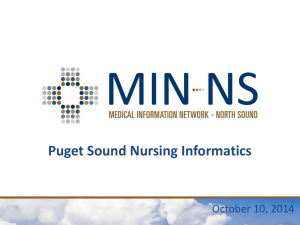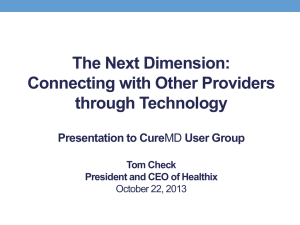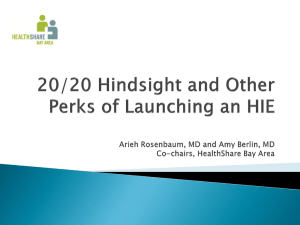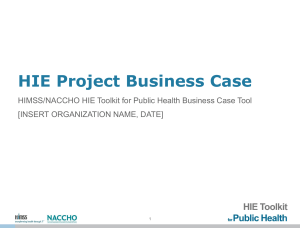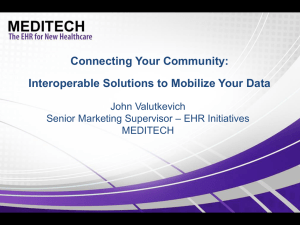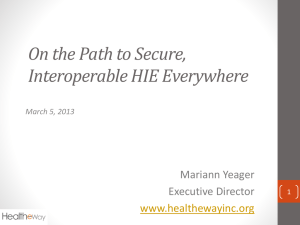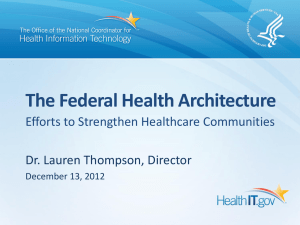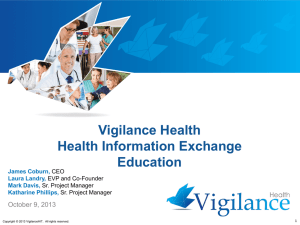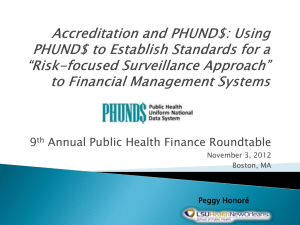HIE HIO Direct Webinar PowerPoint Presentation
advertisement
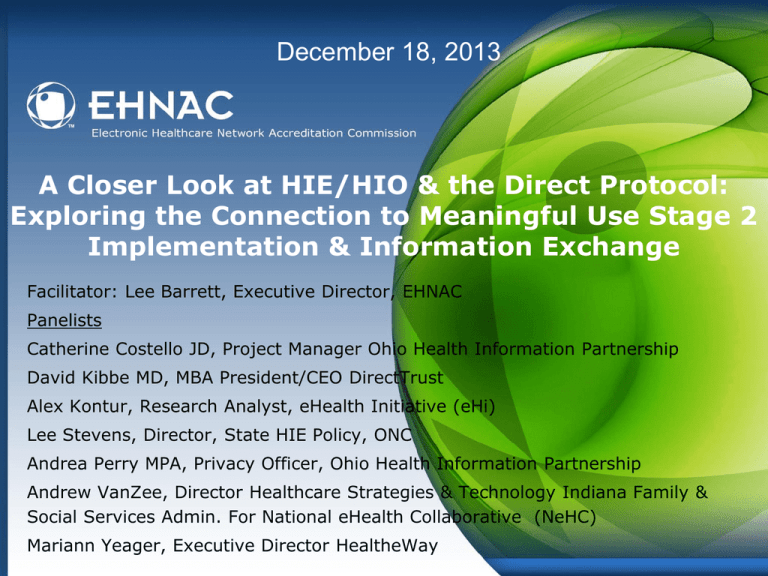
December 18, 2013 A Closer Look at HIE/HIO & the Direct Protocol: Exploring the Connection to Meaningful Use Stage 2 Implementation & Information Exchange Facilitator: Lee Barrett, Executive Director, EHNAC Panelists Catherine Costello JD, Project Manager Ohio Health Information Partnership David Kibbe MD, MBA President/CEO DirectTrust Alex Kontur, Research Analyst, eHealth Initiative (eHi) Lee Stevens, Director, State HIE Policy, ONC Andrea Perry MPA, Privacy Officer, Ohio Health Information Partnership Andrew VanZee, Director Healthcare Strategies & Technology Indiana Family & Social Services Admin. For National eHealth Collaborative (NeHC) Mariann Yeager, Executive Director HealtheWay Agenda • L. Barrett: Panel Intro. & Setting the Stage • L. Stevens: ONC Nationwide HIE Strategy • A. Kontur: eHi 2013 HIE survey and Summit key topics • A. VanZee: NeHC Workgroup Certification/Accreditation Inventory initiative • M. Yeager: HealtheWay Exchange Connectivity • D. Kibbe: The role of DirectTrust and the Direct Protocol • C. Costello/A. Perry: OHIP Case Study • Q&A 2 Webinar Objectives • Explore how organizations can assure interoperability and scalable trust; • Explain the significant differences between EHR technology software certification and security/trust accreditation for HISPs, CAs and RAs who partner with EHRs; • Provide best practice examples of how to facilitate security, interoperability and trust among exchange participants, fostering public confidence, and promoting the adoption and success of all exchange stakeholders; 3 Webinar Objectives cont. • Describe ways to reduce PHI exposure risks through the demonstration of comprehensive risk management programs; and • Outline how to prepare your exchange for implementation of secure communications in support of Meaningful Use requirements by the ONC. 4 Challenges • Understanding the role of the various industry organizations • What are the various exchange models in use today • Stakeholder Trust • Managing Risk & Risk Mitigation • Privacy and security issues 5 L. Stevens: Nationwide HIE Strategy 6 Nationwide HIE Strategy Lee Stevens Director State Health Information Exchange Policy Office ONC Information Securely Follows Patients Whenever and Wherever They Seek Care QUERY-BASED EXCHANGE MULTIPLE MODELS DIRECTED From Health Affairs, March 5, 2012 CONSUMER-MEDIATED EXCHANGE 8 HIE Market Reality • HIE facilitated by a variety of organizations/sources including: – HIOs – HISPs – EHR vendors – National services providers – Hospitals – ACOs – Health Center Controlled Networks – Others 9 ONC’s Approach • HIE is a journey, not a destination • Leverage government to create conditions of exchange • Health information exchange is not one-size-fits-all • Multiple approaches will exist side-by-side • Build in incremental steps – “don’t let the perfect be the enemy of the good” 1 0 ONC’s Role Reduce Cost and Increase Trust and Value To VALUE Mobilize Exchange • Payment COST Standards: identify and urge adoption of scalable, highly adoptable standards that solve core interoperability issues for full portfolio of exchange options Market: Encourage business practices and policies that allow information to follow patients to support patient care HIE Program: Jump start needed services and policies • • reforms Meaningful Use Wide-scale adoption TRUST • Identify and urge adoption of policies needed for trusted information exchange ONC 11 The State HIE Program (data as of Q2 2013) VT WA MN OR ID ME WI MI WY PA IA NE NV IL CO KS MO OH IN MD WV VA Directed Directedexchange exchangemechanisms available in regions mechanisms broadly available MA NY SD CA Directed Exchange Color Legend ND MT UT NH RI CT NJ DE Directed exchange mechanisms being piloted Directed exchange mechanisms not available KY NC TN AZ OK NM SC AR MS AL GA FL TX Other states and territories AK HI AS CNMI DC PR GU USVI LA Query-Based Exchange Pattern Legend Query-based exchange mechanisms broadly available Query-based exchange mechanisms available in regions •Only 3 territories do not have operational exchange options available for providers today •Most states now offer both directed and query exchange options to providers State HIE Program Progress Adoption Total number of clinical and administrative staff enabled for directed exchange nationally Total number of clinical and administrative staff enabled for query-based exchange nationally CY Quarter 2, 2012 44,061 CY Quarter 2, 2013 119,853 63,477 152,132 13 State HIE Program Progress Transactions Total number of directed transactions nationally Total number of patient record queries nationally CY Quarter 2, CY Quarter 2, 2012 2013 72,766,216 270,855,385 2,524,385 11,662,380 14 Focus on Exchange in the Stage 2 Meaningful Use Criteria • E-prescribing • Transition of Care summary exchange: • Create & transmit from EHR • Receive & incorporate into EHR • Lab tests & results from inpatient to outpatient • Public health reporting – transmission to: • • • • Immunization Registries Syndromic surveillance Reportable lab results Cancer Registries • Patient View, Download and Transmit to 3rd Party Care and Payment Reform Activities • Inter-professional Education & Inter-collaboratory Practice Models • Patient Centered Medical Home (PCMH) • Pay for Performance (P4P) – Programs to pay for value; not for volume (outcome; not services) • Accountable Care Organizations (ACO) – Shared Savings Program (SSP) – Advanced Payment ACO Model – Pioneer ACO Model • Center for Medicare & Medicaid Innovation Programs (CMMI) – State Innovation Models Initiative (SIM) – Comprehensive Primary Care Initiative (CPC) – Bundled Payments for Care Improvement Program (BPCI) – Community-based Care Transitions Program (CCTP) 16 Strategies to Advance Nationwide Exchange • Enable a governance infrastructure, including a trust framework, that reduces barriers to exchange • Coordinate across federal government partners on HIE funding, innovations and implementations • Create shared learning opportunities to identify best practices and lessons learned to advance exchange – Coordinate between real world implementers and the S&I Framework to test standards and develop implementation guidance – Convene implementers to develop and implement “solution packages” to thorny and important exchange challenges to drive towards nationwide adoption 17 Strategies to Advance Nationwide Exchange • Support HIE as an important element of meaningful use of EHRs – Help vendor community (EHR and HIE) understand meaningful use requirements and options – Help identify and resolve technical and policy issues – Better understand vendor needs and challenges and help coordinate practical solutions 18 Strategies to Advance Nationwide Exchange • Support state-level and community HIT-enabled care transformation – Work with CMS and vanguard states to develop models for developing and deploying HIT infrastructure at the state level to support payment reform and care transformation – Support states in using policy, contracting, regulatory and convening levers to build a stronger business case for exchange and address the exchange needs of payment reform – Convene state policy leaders, federal partners and other leaders to tackle and resolve specific issues confronting on the ground implementers who are using HIT to support state-level care transformation including quality reporting, analytics, care coordination and patient engagement. 19 Conclusion • Nationwide HIE will include directed, query and consumer based exchange • There will be a variety of sources for exchange • Exchange will develop incrementally • MU and payment reform are important policy levers for exchange • Governance is required to develop the trust that will enable data to flow between unaffiliated organizations • Adherence to nationwide standards and certifications will remove the “stove pipes” • States will continue to be a key strategic partner as HIE supports payment reform and state health goals 20 Stay Connected • • • • Browse the ONC website at: healthIT.gov Contact us at: onc.request@hhs.gov Follow our blog: http://www.healthit.gov/buzz-blog/ Ask a question: BlueButton@hhs.gov • Subscribe, watch, and share: @ONC_HealthIT http://www.youtube.com/user/HHSONC HealthIT and Electronic Health Records http://www.scribd.com/HealthIT/ http://www.flickr.com/photos/healthit Alex Kontur: eHi 2013 HIE Survey and Summit Key Topics 22 2013 Data Exchange Survey Results About eHealth Initiative • Since 2001, eHealth Initiative is the only national, non-partisan group that represents all the stakeholders in healthcare. Represents over 15 different stakeholder groups and 39 states across the nation. • Mission to promote use of information and technology in healthcare to improve quality, safety and efficiency. • Last year, over 4500 individuals attended our events and 500+ individuals participated in our national councils and workgroups • eHealth Initiative focuses its research, education and advocacy efforts in four areas: – Data and Analytics – IT Infrastructure to Support Accountable Care – Technology for Patients with Chronic Disease – Data Exchange & Interoperability 24 About the 2013 Survey • 10th annual survey • Comprehensive survey to determine the state of the field; covers governance, sustainability, operations, stakeholder participation, privacy policies, and more • 199 of 315 identified organizations completed the survey – 90 community HIEs, 45 SDEs/state HIEs, 50 healthcare delivery organizations, others include public health, payers 25 What We’ve Learned • 84 have reached stage 5 (operational) or higher • Who provides HIEs with data? – Hospitals (160), ambulatory care providers (142), independent labs (85), community and/or public health clinics (82) • Who accesses data? – Ambulatory care providers (159), hospitals (145), community/public health clinics (105), behavioral or mental health (90) 26 What We’ve Learned • Interoperability is a major concern – 142 respondents cited interoperability as a pressing challenge – 151 organizations have had to build interfaces with disparate systems (68 have had to build 10 or more; 32 have had to build 5 or more) • 65 participate in an ACO; 65 plan to do so in the future • 90 currently use Direct – Transitions of care is the most common use case (65) – 30 are NOT planning to use Direct 27 What We’ve Learned • What services do HIEs offer? – Connectivity to EHRs (125), exchange of health summaries (115), master patient index (114), results delivery (104), provider directory (84) • What data types are available? – Results (131), admission/discharge summaries (125), care summaries (125), diagnoses (115), CCDs (113), allergy info (113), patient histories (111), medication data/prescriptions (109) 28 What We’ve Learned • Who is funding HIE? – Hospitals (79), state or federal funding (64), ambulatory providers (38), private payers (23), Medicaid (15) • How? – Memberships fees (71), assessment fees (66), fees for specific services (48), state funds (39) federal funds (34) • Are they sustainable? – About half (52) receive sufficient revenue from participants to cover operational expenses 29 What We’ve Learned • Opt-out is the most common consent model (115) • 109 organizations do not offer patients granular consent controls – controls for sensitive information are most common (43) • Limited patient access – 31 organizations offer patients access to their data – 102 plan to offer access in the future – 56 have no plans to do so 30 Looking Forward • Evolving sustainability plans – Private payers – less emphasis on public sources – shift to service fee model • HIEs are turning the corner – Interoperability is now a more pressing concern than sustainability 31 Looking Forward • Health reform has helped create the business case for HIE, and service offerings will reflect this – HIEs anticipate offering provider alerts (83), patient access (78), analytics (74), reporting to disease registries (66) 32 Thank You! Contact info: Alex Kontur 202.624.3280 akontur@ehidc.org 33 Andrew VanZee: NeHC Workgroup Certification/Accreditation Inventory Initiative 34 Definitions *As determined by the Accreditation & Certification workgroup Accreditation • A process in which certification of competency, authority, or credibility is presented • The accreditation process ensures that their policies and practices are acceptable, that organizations behave ethically and employ suitable quality assurance and, if appropriate, that they are competent to test and certify third parties Certification • The process of certifying that a certain product has passed performance tests and quality assurance tests, and meets qualification criteria stipulated in contracts, regulations, or specifications 35 Forum HIE Accreditation and Certification Workgroup Workgroup Charge • Develop an inventory of national, regional, and state accreditation and certification programs, providing a landscape of these efforts including their purpose, scope and source of authority Workgroup Purpose • This landscape will provide stakeholders with an understanding of the categories of programs, where and why they are emerging, and what they are intended to address 36 Accrediting and Certifying Organizations Data Request • Key accreditation and certifying bodies, including state designated entities, were invited to share information to provide understanding of the HIE accreditation and certification landscape – Purpose of Accreditation/Certification program: – Who is this accreditation/certification relevant to? Who is the target audience? – What is the scope (technical, policy, etc.)? – What are the issues that are addressed? – What are the types of assurances that are gained? – What is the source of the authority; i.e. state, regional, national organization? – Is the program voluntary or required? – Is it an evaluation or a registry? – Are there any standards that are being used as a baseline for their certification or accreditation? – Are you aware of any overlap in the industry regarding HIE accreditation and certification? If yes, please provide details on overlap. – What are the gaps in current HIE accreditation or certification activities; i.e. what other matters would be best served by receiving an accreditation or certification by a third party? – What type of entity is best suited to perform this additional verification? 37 Organizations Who Provided Information National - Surescripts - EHNAC CCHIT DirectTrust Healtheway - Statewide State of Indiana State of Kansas State of Pennsylvania State of Vermont Minnesota Dept. of Health State of Texas 38 Initial Conclusions from Information Gathered from Accrediting and Certifying Organizations • A continuing theme around these efforts is that to increase trust and interoperability. • Much of the target audience consists of HISPS, HIOs, providers, vendors, or HIEs. • The scope of the accreditation & certifications center around: – Technology – Policy/Legal including trust agreements – Security – Financial Sustainability including fee structures • Approximately half are required and half are voluntary with some – Texas – being voluntary unless you would like to be listed as a trusted entity. • The majority of accreditation & certifications are evaluations • Many states are using national sources like EHNAC, DirectTrust, Healtheway, and CCHIT as a basis for their accreditation and certification efforts but some – Vermont, Indiana mostly, and Pennsylvania – pull from other sources as well. 39 Potential Gaps • What are the gaps in current HIE accreditation or certification activities; i.e. what other matters would be best served by receiving an accreditation or certification by a third party? – We do not yet have a reliable and comprehensive testing and certification service unique for HISP/STAs. These entities may be partially tested and certified when using specific EHR vendor modules as “relied upon software” within the context of the 2014 Edition Certificate Criteria. However, not all HISPs have these partnerships. 40 Additional Verification • What type of entity is best suited to perform this additional verification? – Initially at this early stage, state programs are adequate; however ultimately a public/private non-profit should be responsible – Verification standards and other criteria should be set by a community entity or government – Verification against criteria should be performed by an independent third party 41 Data Request of Non-Accrediting and Certifying Organizations • Invited non-certifying bodies to provide information about accreditation and certification programs they are subject to. – Organization Name: – What HIE accreditation and certifications are you required to comply with? – What voluntary HIE accreditation and certifications do you currently comply with? – Are they evaluation or registries? – Are you aware of any overlap in the industry regarding accreditation and certification requirements? – What are the gaps in current HIE accreditation or certification activities; i.e. what other components would be best served by receiving an accreditation or certification by a third party? – What type of entity is best suited to perform needed accreditation or certification? 42 Non-Accrediting and Certifying Organizations Who Provided Information - Great Lakes HIE (GLHIE) - Brooklyn Health Information Exchange (BHIX) - Rhode Island Quality Institute (RIQI) - Oregon Health Authority/CareAccord (OR HIE) - ConnectHealthcare - Advanced Answers on Demand, Inc. 43 Initial Conclusions from Non-Accrediting and Certifying Organizations • The majority of respondents are not required to comply with any accreditation or certification programs although states (OR, NY) are slowly developing these programs that may be required in the future. • Many are voluntarily certified and accredited with EHNAC and CCHIT. • Many did not understand the question about registries vs. evaluations so we did not receive a good sense of their answer. • Most were not aware of any overlap in the current requirements. • Meaningful Use and HIE was cited by two respondents as a potential gap that could be filled by a third party. • Two respondents cited an “independent” organization as the best one to administer the needed certification and/or accreditation. Some cited EHNAC or CCHIT. One suggested a government agency or accreditation commission. One suggested an entity who was fluent in the laws of the specific state. 44 Entities to Perform Needed Programs • What type of entity is best suited to perform needed accreditation or certification? – An entity best suited to perform accreditation or certification of Qualified Entities in New York State would be one that comprehends the complexity of the HIE environment from many perspectives, including but not limited to technical applications, policy and privacy concerns, overall operations as well as the business community. The entity would also need to be well versed in Federal Law, New York State Law as well as emerging New York State Policy Guidance which governs health information exchange. – We believe the current ATCB process with entities like CCHIT are the best. 45 Suggested Next Steps • Continue to inform and educate the community on the types of accreditation and certification programs, status, and progress. • Raise awareness of the value proposition and business case for accreditation and certification. • Identify a neutral, credible third-party organization and encourage them to keep track of current accreditation and certification programs for community reference. • Encourage above organization to build on current landscape work and collaboratively identify gaps and consider how best to fill them. 46 Mariann Yeager: eHealth Exchange Enabling Care Coordination and Transitions of Care 47 eHealth Exchange • Establishes framework that community of exchange partners use to interconnect directly with each other based upon a common set of rules of the road – Technical requirements verified through technical testing – Common expectations regarding privacy and security and other exchange obligations • Compliance with rules of the road enforced by contract • Participants can exchange for multiple use cases and different work flows under this common framework – Push of clinical documents – Query / retrieval of information for treatment, transitions of care, care coordination, Social Security disability benefits, etc. 48 eHealth Exchange Anchor Participants 49 Healtheway Corporate Members 50 eHealth Exchange Growth • Participation reaching critical mass – 40+ Participants – 59 in testing phase – Hundreds of hospitals, thousands of physician practices, millions of patients – Dozens of others planning to onboard • National-level coverage increasing; reaching tipping point of adoption • Collaboration extending breadth and depth of connectivity – Care Connectivity Consortium – Kaiser Permanente, Mayo Clinic, Geisinger, Group Health Cooperative, Intermountain Healthcare • Meaningful Use (Stage 2) is one factor driving adoption among vendors and providers 51 2014 Certified EHR Technology: Transitions of Care Measure #2 • The EP, EH or CAH that transitions or refers their patient to another setting of care or provider of care, provides of summary of care record for more than 10% of such transitions and referrals as follows: a) Electronically transmits C-CDA using CEHRT to a recipient (e.g. using Direct, Direct + XDR/XDM, SOAP transport protocols) b) Where the recipient receives the summary of care record via exchange facilitated by an organization that is an eHealth Exchange participant; or c) In a manner that is consistent with governance mechanism that ONC establishes for the nationwide health information network 52 eHealth Exchange: Lessons Learned – Participants trust others in the eHealth Exchange community based upon 3 key elements: • Rules of the road (technical, policy, etc.), including obligations for privacy and security are enforced contractually (Data Use and Reciprocal Support Agreement) • Assurance of interoperability that has been tested and verified • Participants have eHealth Exchange digital certificates (FBCA) – To assure interoperability, technical testing is essential to verify: • Conformance to the underlying standards / specifications; and • Assure that known interoperability issues are not introduced into production – Ability to test once: exchange with many – Automation is key to enabling efficient and robust testing – Rigorous product testing will lower the burden of participant / partner testing 53 eHealth Exchange Product Testing • Healtheway launching eHealth Exchange Product Testing Program in early 2014 – Focus on compliance and interoperability testing – Maintain tested product list: eHealth Exchange Validated Systems – Not formal product certification • Will substantially off-set level of technical testing that eHealth Exchange participants need to complete 54 David Kibbe: The role of DirectTrust and the Direct Protocol 55 DirectTrust Mission and Goals DirectTrust.org, Inc. (DirectTrust) is a voluntary, selfgoverning, non-profit trade alliance dedicated to the growth of Direct exchange at national scale, through the establishment of policies, interoperability requirements, and business practice requirements. DirectTrust operates under a Cooperative Agreement with ONC to support its work of creating a national network of interoperable Direct exchange services providers. Security & Trust Framework EHNACDirectTrust Accreditation Program Trust Anchor Bundle Distribution 56 57 Current DTAAP Accreditation Roster Fully Accredited and Audited Candidate Status • CareAccord • • • • • • • • • • • • • • • • • • • • • • • • Cerner Corporation • DigiCert • Infomedtrix • ICA • Inpriva • MaxMD • Surescripts • MedAllies Applied Research Works Athenahealth Covisint DataMotion EMR Direct GlobalSign HIXNy Health Companion, Inc Health Connection CNY iMedior IOD Inc. Medicity MRO Corporation Orion Health NYeC RelayHealth Rochester RHIO Secure Exchange Solutions Simplicity Health Systems Truven Health Analytics Updox Utah Health Information Network Vitalz Technologies, LLC 58 Building a National, Secure Direct Network Transitional Trust Bundle (PKCS7) membership DTAAP Candidate Status + Federation Agreement Trust Anchor Review DTAAP Full Accreditation and Audit Status Trust Anchor Review Accredited Trust Bundle (PKCS7) 59 of Trust Communities EHR 1 PHR Public Health Lab EHR 1 Hospital Group B EHR 2 Cancer Registry HIE a Trust Community B Rx Health System A PHR Long Term Care EHR 14 Long Term Care HIE b HIO c EHR 3 Rural Health System Trust Lab Retail Clinic Public Health Rx Community C Trust Community A 60 Benefits to health care and public good • All participants can reach other participants served by accredited HISPs, regardless of location, organization, or health IT system. A valuable network. • Every EHR technology certified for 2014 as “Direct ready” will be able to either be an accredited HISP, or partner with one. Eligible physicians and hospitals will be able to attest to Stage 2 MU objectives for Transitions of Care and View, Download, and Transmit. • Additional uses of Direct exchange are emerging quickly, e.g. transport of claims attachments, referrals from Federal Agencies, automated alerts and reminders. 61 David C. Kibbe MD, President and CEO DirectTrust.org David.Kibbe@DirectTrust.org kibbedavid@mac.com 913.205.7968 62 Ohio Health Information Partnership/CliniSync HIE Cathy Costello, JD Regional Extension Center/MU ccostello@ohiponline.org Andrea Perry, MPA Privacy Officer aperry@ohiponline.org 63 Ohio’s HIE Landscape HIE structure: o CliniSync: Brand name for The Ohio Health Information Partnership’s HIE; State Designated Entity o HealthBridge: HIE covering Cincinnati, northern Kentucky Technology vendor: o CliniSync HIE Vendor: Medicity 64 Ohio’s Major EHR Vendors Acute Ambulatory EPIC Meditech Allscripts Cerner McKesson CPSI Healthland EPIC Allscripts e-MDs Greenway NextGen eClinicalWorks Athena Cerner CliniSync Ambulatory Connections Ohio’s Committed Hospitals Green: CliniSync Live Hospitals Yellow: CliniSync Contracted Hospitals Blue: HealthBridge Live Hospitals Almost 90% of hospitals in Ohio have committed to an HIE. Over 87% of 11.5M Ohioans are being served. 141 Hospitals Contracted with CliniSync in Ohio 67 MU Measures Requiring Exchange Fall Into One of Three Basic Categories Transitions of Care Patient Engagement Public Health Reporting • Measures that require hospitals and providers to share structured summary of care records electronically for each transition of care or referral • Measures that require hospitals and providers to share or communicate information with patients electronically • Measures that require hospitals and providers to report information to the Ohio Department of Health for public health reporting purposes 68 Implementation of Meaningful Use Stage 2: Certification and Credentialing for the HIE Medicity •2014 ONC Stage 2 EHR Modular Certification (Required; National) •Healtheway Certification (Required; National) •DTAAP HISP, CA and RA (Voluntary; National) CliniSync •Site Administrator Credentialing •Healtheway Certification (Required; National) •DTAAP RA (Voluntary; National) Hospitals/ EPs •2014 ONC Stage 2 EHR Certification (Required for the CEHRT vendor; National) •Site Administrator Credentialing (Required; CliniSync) •Authorized Users Credentialing (Required; CliniSync) 69 Site Administrator for CliniSync Participants in the HIE “The Site Administrator is responsible for performing duties related to authentication, determining appropriate access requirements, and notifying CliniSync in instances of improper use as defined by CliniSync policy.” - CliniSync Policy Manual for Participating Organizations 70 Credentialing Site Administrators Identity Verified Against Following Databases • State of Ohio Medical Licensing Board • NPPES • Ohio Secretary of State Business Registry Required Identity Documentation • One federal government issued photo ID, a REAL ID Act compliant Driver’s License or • Two non-federal IDs, one of which is a photo ID (e.g. NonREAL ID Act compliant Driver’s License 71 Authorized Users Credentialing Process for Access to the HIE Site Administrator Responsibilities • Designate authorized users from among its own organizations workforce • Perform duties related to authentication • Determining appropriate access requirements (Role Based Authorization) • Notifying CliniSync in instances of improper use as defined by CliniSync policy 72 Process of Obtaining Consent for Protected Health Information (PHI) to Move in the HIE CliniSync (State Level) Credentials Site Administrator Site Administrator (Local Level) Credentials Authorized User Authorized User (Local Level) Obtains Patient Consent for HIE Transfer of Records 73 Development of CliniSync Consent Policy • The CliniSync consent policy was developed over 1½ years. • Committee was composed of healthcare attorneys from around the state. • Policy ultimately vetted by over 75 Ohio healthcare attorneys. • End product was a common consent policy for HIE adopted for all participants in Ohio. • CliniSync is working to embed consent in the workflow of hospitals and physician practices. 74 CliniSync Consent Policy • Consent is not required for directed exchange between providers to coordinate care (HIPAA covers this). • Consent is required to query or search the HIE for patient information. • A provider must have a treatment relationship with the patient. This is tracked in the CliniSync system. • Patients can opt out of CliniSync if they so choose. 75 Universal Health Information Exchange Consent Health Information Exchange is a secure way for your health care providers to get the most up-to-date medical information about you. If you sign this consent, your health care provider may search for and get your test results, lab results, X-rays, medication list or any other health information that has been electronically collected from other participating providers. Information that could help save your life in a medical emergency would be available to the health care providers treating you. Only health care providers who have a treatment relationship with you will be authorized to search for your records. Consenting and Cancellation If you consent, you only have to give your consent one time. You can withdraw your permission at any time by completing a Cancellation Request and submitting it to your health care provider. They will have the form or you can get it at www.clinisync.org. Please check one of the boxes below. I consent to have my records shared through the Health Information Exchange. I have read this form. I have had a chance ask questions. I am satisfied with the answers. I do not want to have my records shared on a Health Information Exchange. I understand that this means that even in an emergency, my treating physicians may not have access to my previous records from other treating physicians. I have read this form and have had a chance to ask questions. Patient Name: ______________________________ _______________________________ Parent/ Guardian: Signature:__________________________________ Signature:______________________________________ Date: ______________________ ________________________ Date: All individuals 14 and over must sign as a patient, and individuals under 18 must also have a parent or guardian sign this form. 76 Keep your data private and secure. • Security issues are high priority for the HIE. • Only authorized, treating clinicians can access a patient’s data. • When dealing with teens, get their permission. 77 78 Questions 79
